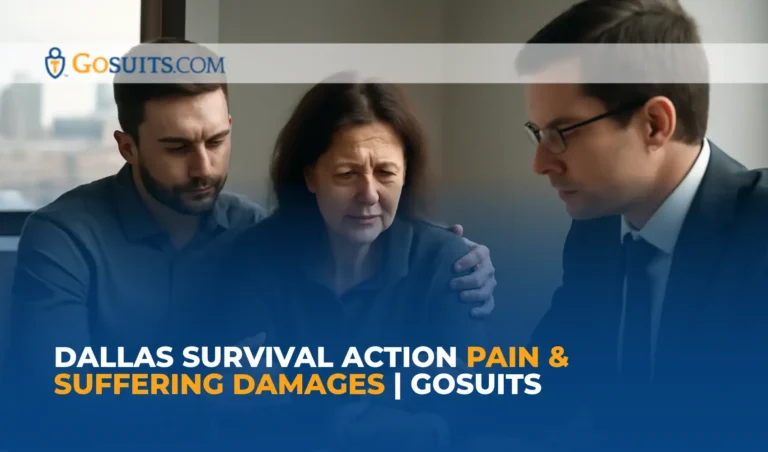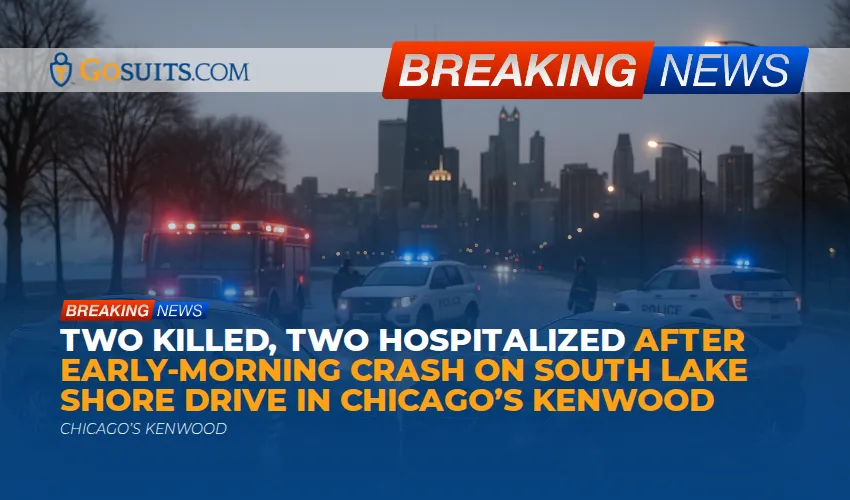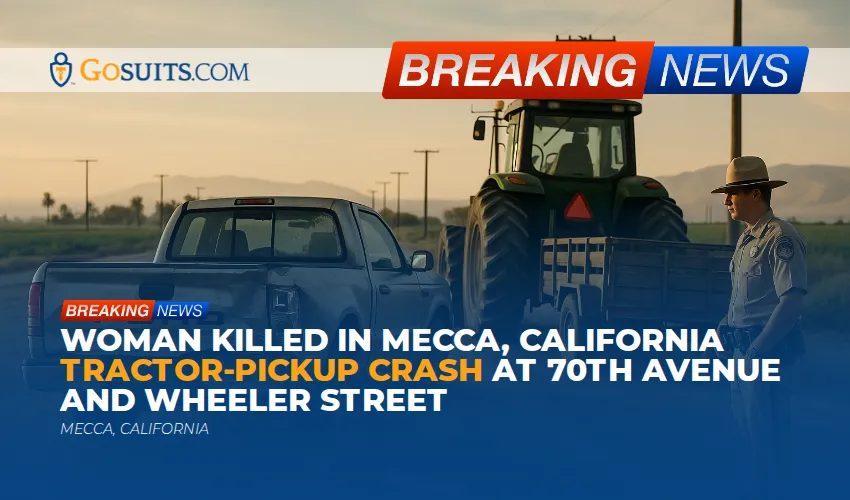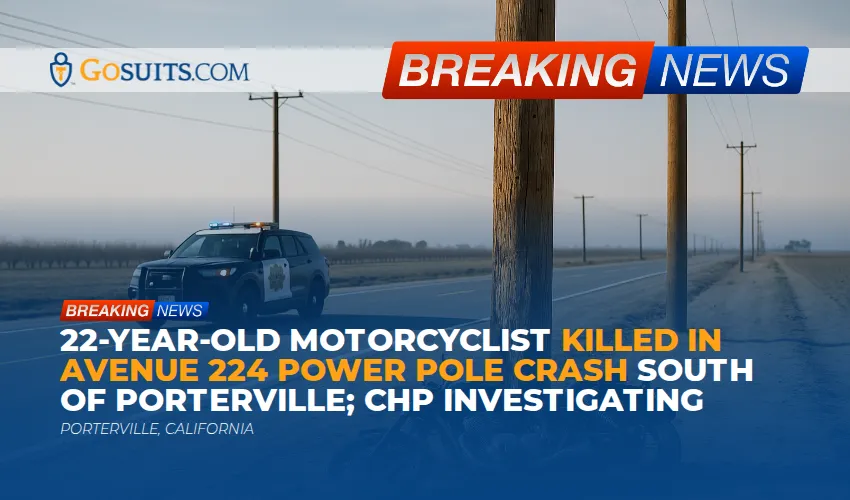- What is a Dallas survival action and how is it different from wrongful death?
- Who can file a survival action in Texas after a fatal Dallas car crash?
- What damages are available for pre-death pain and suffering in Texas?
- How do Texas courts evaluate conscious pain and suffering?
- What evidence helps prove the decedent experienced pain and suffering?
- How are medical bills and funeral costs handled in a survival action?
- Is there a cap on pain and suffering damages in Texas survival actions?
- Can the estate seek punitive damages in a Dallas survival case?
- What deadlines apply to Dallas survival actions and are there tolling rules?
- Who receives survival action proceeds and how are they distributed?
- How does a survival action coordinate with a wrongful death claim?
- How are non-economic damages like pain and suffering calculated?
- What defenses do defendants raise in Dallas survival cases?
- How do comparative responsibility and credits affect recovery?
- What special issues arise if the defendant is a government entity?
- What is the typical process for a survival action in Dallas County?
- Which local courts and rules apply in Dallas civil cases?
- What should families gather right away after a fatal Dallas crash?
- How can legal help make a difference in proving pre-death pain and suffering?
- About GoSuits: technology‑forward, trial‑tested injury lawyers
- Resources cited
What is a Dallas survival action and how is it different from wrongful death?
In Texas, a survival action allows the legal claim the person had before passing to continue through their estate. It is brought for the harms the person suffered between the injury and death, including conscious pain and suffering, mental anguish, medical expenses, and related losses that the person could have claimed had they survived. The Texas Civil Practice and Remedies Code states that a personal injury claim does not abate because of death and survives to the heirs, legal representatives, and estate of the injured person. See Tex. Civ. Prac. & Rem. Code § 71.021.
By contrast, a wrongful death claim compensates the surviving spouse, children, and parents for their own losses resulting from the death. See Tex. Civ. Prac. & Rem. Code § 71.004. Wrongful death covers losses such as loss of companionship and financial support to the family, while a survival action belongs to the estate and focuses on what the decedent suffered before passing.
Dallas families often pursue both claims after a fatal car accident on I‑35E, Central Expressway, or the Dallas North Tollway. The two claims compensate different harms and involve different beneficiaries, and Texas law permits them to proceed together when supported by the evidence under Chapter 71.
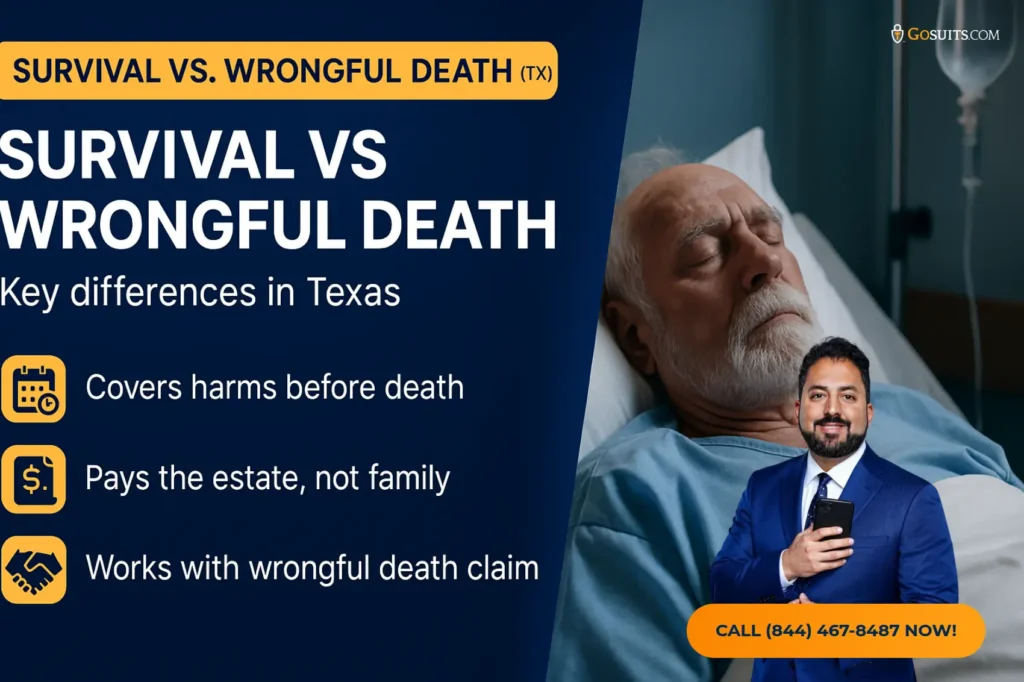
Who can file a survival action in Texas after a fatal Dallas car crash?
Under the survival statute, the claim continues in favor of the deceased person’s heirs, legal representatives, and estate. See § 71.021. Practically, that usually means:
- The personal representative of the estate files as plaintiff, either the court‑appointed independent executor named in a will or an administrator appointed by a probate court.
- Heirs may file on behalf of the estate if there is no administration and other requirements are met under Texas law governing capacity to sue in a survival claim. State law library materials explain that survival claims may be brought by the estate’s representative or, in some circumstances, the heirs. See the Texas State Law Library guide to wrongful death and survival actions at guides.sll.texas.gov.
Standing and capacity can be technical, specifically if probate is pending in Dallas County or Collin County. Getting the right party named at the start helps avoid delays and defenses to capacity later in the case.
What damages are available for pre-death pain and suffering in Texas?
Texas law allows recovery of the decedent’s damages that accrued between the injury and death, including non‑economic and economic losses. Although § 71.021 does not list categories, Texas courts and standard practice recognize the following types of survival damages:
- Conscious pain and suffering for the physical discomfort and distress experienced before death.
- Mental anguish and emotional distress suffered by the decedent before death.
- Medical expenses reasonably and necessarily incurred as a result of the injury.
- Lost earnings from the injury date to the date of death, if evidence supports that the person missed work during that period.
- Funeral and burial expenses when paid by or chargeable to the estate.
For definitions, many courts describe pain and suffering as compensation for physical pain, discomfort, and the accompanying mental reaction to that pain. See, generally, dictionary.law.com definition of pain and suffering. The Texas State Law Library’s public guide on wrongful death and survival actions provides an accessible overview of what these parallel claims cover and who may bring them. See Texas State Law Library: Wrongful Death and Survival.
How do Texas courts evaluate conscious pain and suffering?
To recover non‑economic damages for pain and suffering in a survival action, there must be evidence that the decedent was conscious and aware of pain for some period after the injury. Courts look for proof of awareness, which may be shown through direct medical testimony, eyewitness accounts, or circumstantial evidence such as movement, vocalization, or responsiveness. The factfinder evaluates credibility and the weight of the evidence under the Texas Rules of Evidence. See Texas Rules of Evidence (relevance and opinion testimony).
Evidence of consciousness does not have to be lengthy in time, but it must be sufficient to convince a jury that the person experienced pain or mental anguish between the collision and death. In Dallas County cases arising from high‑speed crashes on LBJ Freeway or U.S. 75, EMS and emergency department records often become crucial to this analysis.
What evidence helps prove the decedent experienced pain and suffering?
Every case is unique, but in North Texas survival actions common sources of proof include:
- EMS and ER records documenting Glasgow Coma Scale scores, responsiveness, pain responses, sedation, or intubation times.
- Treating physician and nurse testimony about the patient’s level of consciousness, complaints of pain, and interventions.
- Eyewitness accounts from passengers, bystanders in Deep Ellum or Uptown Dallas, or first responders who observed speech, groaning, movement, or other signs of awareness.
- Body‑worn and dash‑camera video from Dallas Police Department or Irving Police responding to the scene.
- Accident reconstruction and biomechanics that connect the forces of impact to likely pain during the interval before death.
- Autopsy and medical examiner findings describing injuries consistent with pain before loss of consciousness.
- Personal items and digital data such as smartwatch health metrics showing heart rate spikes or other physiological responses.
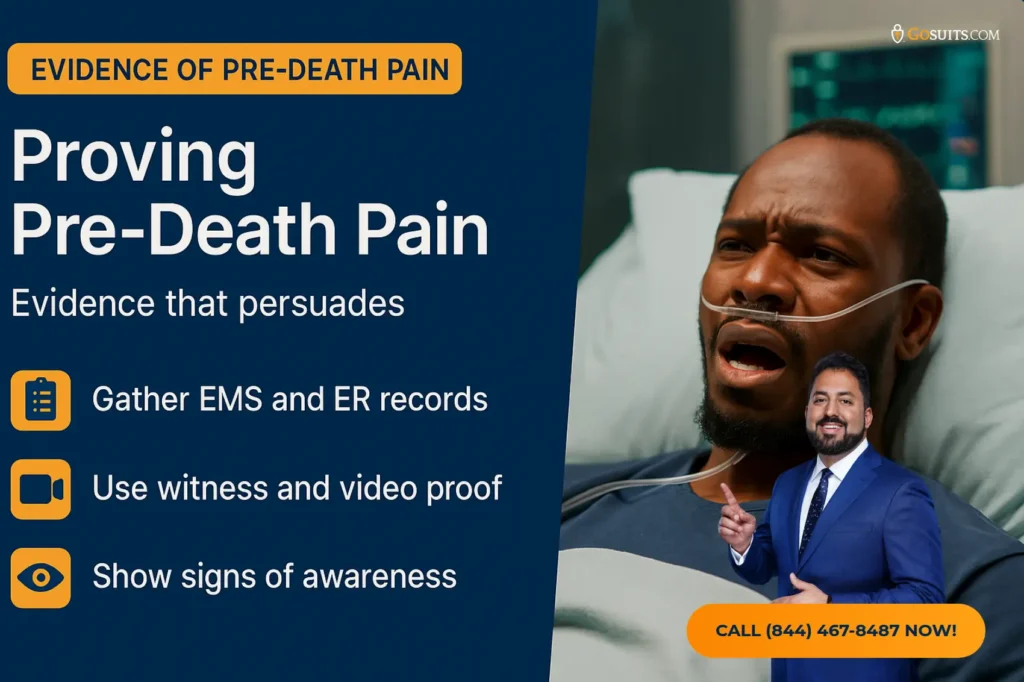
The evidence must be admissible and relevant under the Texas Rules of Evidence, including Rules 401 to 403 and opinion testimony rules. See Texas Rules of Evidence.
How are medical bills and funeral costs handled in a survival action?
Reasonable and necessary medical bills caused by the crash and incurred before death may be recovered by the estate through the survival claim. Funeral and burial costs may also be recoverable when paid by or chargeable to the estate. Those amounts must be proven with competent evidence of necessity and reasonableness, which often includes billing records, affidavits, and testimony consistent with the Texas Rules of Evidence.
Prejudgment interest typically accrues on past damages in personal injury, wrongful death, and survival actions. See Tex. Civ. Prac. & Rem. Code § 304.102. The applicable interest rate is set by statute and periodically adjusted. See Tex. Fin. Code § 304.003.
Is there a cap on pain and suffering damages in Texas survival actions?
For most negligence cases arising from a fatal car accident in Dallas, there is no general cap on non‑economic damages such as pain and suffering. Two important exceptions may apply:
- Claims against governmental entities are subject to the Texas Tort Claims Act, which limits total damages recoverable and may limit non‑economic components within the overall cap. See Tex. Civ. Prac. & Rem. Code § 101.023.
- Statutory caps for other specific claim types can apply in limited categories defined by Texas statutes. Always analyze the defendant’s status and the statutory framework for the claim.
There is no mathematical formula in Texas law for valuing pain and suffering; juries are instructed to award a fair and reasonable amount based on the evidence.
Can the estate seek punitive damages in a Dallas survival case?
Exemplary damages, often called punitive damages, may be available when the evidence supports the statutory standards such as gross negligence. See Tex. Civ. Prac. & Rem. Code § 41.003. Texas law places caps on exemplary damages in many cases. See § 41.008. Whether punitive damages survive the decedent’s death is a legal question often addressed with the help of case law analysis and the survival statute’s language that the action continues as if the person had lived. See § 71.021.
In drunk driving or extreme speeding crashes on the Dallas North Tollway or I‑30, facts may support a punitive claim if the statutory standards are met by clear and convincing evidence.
What deadlines apply to Dallas survival actions and are there tolling rules?
Limitations periods are critical. Key Texas deadlines include:
- Two‑year statute of limitations for personal injury claims, which generally applies to survival actions because the claim is the decedent’s personal injury claim continued by the estate. See Tex. Civ. Prac. & Rem. Code § 16.003.
- Tolling upon death of a potential party for up to 12 months, providing additional time related to the appointment of a personal representative. See § 16.062.
- Governmental notice requirements if a city, county, or state agency may be liable. The Texas Tort Claims Act generally requires written notice not later than six months after the incident unless the unit had actual notice. See § 101.101.
Because Dallas and surrounding municipalities sometimes have charter‑based notice provisions, families should act quickly to protect all deadlines while focusing on grieving and arrangements.
Who receives survival action proceeds and how are they distributed?
A survival recovery belongs to the decedent’s estate, not directly to wrongful death beneficiaries. That means:
- Proceeds pass through the estate either under the will or, if no will, by Texas intestacy rules.
- Estate creditors may have claims that must be addressed according to the Texas Estates Code’s priority of claims and allowances.
- Different from wrongful death distributions, which go directly to statutory beneficiaries regardless of a will. See § 71.004.
This distinction matters for families in Highland Park, University Park, Plano, Richardson, and across the DFW Metroplex, particularly when estate planning documents exist or there are creditor issues.

How does a survival action coordinate with a wrongful death claim?
When evidence supports both, the estate can pursue the survival claim while family members bring the wrongful death claim. The case often proceeds together in one lawsuit, with different damage elements submitted to the jury. Chapter 71 permits both actions, and the court handles allocation and judgment to reflect the different claimholders. See Tex. Civ. Prac. & Rem. Code ch. 71.
Settlements typically itemize amounts allocated to survival versus wrongful death to facilitate proper distribution through probate and to the beneficiaries.
How are non-economic damages like pain and suffering calculated?
Texas law does not provide a formula. In practice:
- Juries evaluate the evidence of awareness, duration, intensity, and the human impact of the injuries before death.
- Adjusters and lawyers sometimes use per‑diem or multiplier frameworks as negotiation tools, but those are not binding and are not part of Texas statutes.
- Credibility and detail matter, including medical charting, consistent witness accounts, and contemporaneous records from EMS and hospitals in Dallas, Garland, Mesquite, and Grand Prairie.
For general background, NHTSA reports that traffic fatalities remain high nationwide, underscoring the seriousness of these cases. See NHTSA Fatality Analysis Reporting System (FARS). Thousands of fatal crashes occur in Texas each year according to state transportation records, and many involve the Dallas County area, making careful documentation essential in each case.
What defenses do defendants raise in Dallas survival cases?
Common defense strategies include:
- Disputing consciousness by arguing the decedent was immediately unconscious or insensate following the collision.
- Causation challenges claiming an intervening medical event or condition, rather than the crash, caused the signs of distress.
- Reasonableness of medical bills by contesting necessity, causation, or reasonableness of charges.
- Comparative responsibility asserting the decedent was partially at fault under proportionate responsibility principles.
- Limitations and notice defenses based on the two‑year statute of limitations or Tort Claims Act notice rules.
Texas proportionate responsibility rules reduce or bar recovery based on fault allocations. See Tex. Civ. Prac. & Rem. Code § 33.001.
How do comparative responsibility and credits affect recovery?
Texas applies proportionate responsibility in civil cases:
- 51 percent bar rule means a claimant cannot recover if the decedent’s percentage of responsibility exceeds 50 percent. See § 33.001.
- Reduction of damages occurs by the decedent’s percentage of responsibility.
- Settlement credits may reduce the judgment against non‑settling defendants depending on the credit election and Chapter 33 principles.
These allocations can significantly impact both survival and wrongful death recoveries and should be modeled early during case evaluation.
What special issues arise if the defendant is a government entity?
Crashes involving city vehicles, county fleets, or state agencies raise Texas Tort Claims Act issues:
- Notice within six months unless the governmental unit had actual notice. See § 101.101.
- Liability caps differ by unit of government. See § 101.023.
- Immunity waivers are limited to specific circumstances, such as motor‑driven vehicles, and do not extend to all theories.
When a crash involves a city truck in Oak Lawn, a county vehicle near the Dallas County Government Center, or a state trooper on I‑20, additional diligence is needed to satisfy notice and pleading requirements.
What is the typical process for a survival action in Dallas County?
Although timelines vary, a common path looks like this:
- Immediate investigation: secure scene photographs and video, 911 audio, officer body‑worn camera, and crash reports; identify witnesses in Arlington, Fort Worth, and across North Texas.
- Probate coordination: open or confirm an estate proceeding in the appropriate county for a personal representative, if needed.
- Notice preservation: send preservation letters and Tort Claims Act notice when applicable.
- Filing suit: plead both survival and wrongful death claims under Chapter 71 as appropriate, with discovery plan selection under the Texas Rules of Civil Procedure. See Texas Rules.
- Discovery and proof: obtain EMS, ER, and medical examiner records; take depositions of treating providers; develop reconstruction proof.
- Mediation and trial: explore settlement; if unresolved, present admissible evidence of consciousness and damages to the jury.
- Judgment and distribution: allocate verdict between survival and wrongful death; handle probate distribution for survival proceeds.
Which local courts and rules apply in Dallas civil cases?
Survival actions are civil cases typically filed in the Dallas County district courts or county courts at law, depending on the amount in controversy and other factors. While each court may have standing orders or preferences, all Texas civil cases apply the Texas Rules of Civil Procedure and Texas Rules of Evidence. These rules govern pleadings, discovery, disclosures, admissibility of medical records, and trial practice statewide.
What should families gather right away after a fatal Dallas crash?
We know this is a difficult time. The following steps help preserve proof while respecting your family’s needs:
- Get all official records including the Texas Peace Officer’s Crash Report, EMS records, hospital charts, and the medical examiner’s report.
- Identify witnesses and obtain contact information for passengers, bystanders, and first responders in places like Deep Ellum, Oak Lawn, Garland, Mesquite, and Richardson.
- Preserve digital evidence such as vehicle event data, dashcam footage, nearby business surveillance, and phone or smartwatch data.
- Document funeral and medical expenses with invoices, proof of payment, and service details.
- Coordinate estate matters by keeping copies of any will, probate filings, and letters testamentary or letters of administration.

How can legal help make a difference in proving pre-death pain and suffering?
Survival action pain and suffering damages turn on careful, admissible proof of consciousness and awareness. The legal team’s role includes:
- Obtaining complete medical and EMS records quickly and reviewing them for clear signs of pain and awareness.
- Interviewing witnesses respectfully to develop accurate accounts of what the decedent said or did.
- Coordinating with treating providers to explain chart entries about responsiveness, sedation, and procedures.
- Navigating Chapter 71 and Chapter 33 to present both survival and wrongful death claims and address proportionate responsibility.
- Preserving deadlines and notice requirements under Chapters 16 and 101.
Attempting to handle a Dallas survival action alone can be overwhelming while grieving. Legal help allows you to focus on family while your case is developed under the Texas Rules and statutes.
About GoSuits: technology‑forward, trial‑tested injury lawyers
When a fatal car accident happens in Dallas, TX, families often ask how to pursue a survival action for pre‑death pain and suffering while managing probate and funeral arrangements. This is squarely within personal injury litigation. A free consultation with a Dallas car accident lawyer can help you understand eligibility, the evidence needed to show conscious pain and suffering, and how survival and wrongful death claims work together under Texas Civil Practice and Remedies Code Chapter 71.
GoSuits represents injured people and families across Dallas County and the DFW Metroplex, including Uptown Dallas, Oak Lawn, Deep Ellum, Highland Park, University Park, Irving, Plano, Richardson, Garland, Mesquite, Grand Prairie, Arlington, and Fort Worth. Our practice focuses on civil injury and wrongful death cases arising from crashes and other negligence.
- Technology‑driven approach: We use exclusive proprietary software that streamlines records collection, timeline building, and damages modeling, helping move cases faster and with greater clarity.
- Leadership in innovation: Our litigation workflows integrate secure data pipelines, giving clients real‑time visibility into case milestones without sacrificing courtroom preparation.
- Attorney access: Although we leverage technology to expedite work, every client has a designated attorney. We do not use case managers. You have unfettered access to your lawyer throughout your case.
- Trial experience: We prepare cases for trial, which often strengthens negotiation leverage and keeps options open if a fair settlement is not reached.
- Past results: Our results include seven‑figure and high six‑figure resolutions in serious injury and fatality matters. See a sample of prior cases at gosuits.com/prior-cases.
- Practice areas: Motor vehicle collisions, commercial vehicle and 18‑wheeler crashes, premises liability, product injury, and wrongful death.
- Experience: More than 30 years of combined experience in personal injury litigation.
We handle both plaintiff and defense perspectives in analysis to pressure‑test evidence, anticipate defenses, and present clear, admissible proof of pre‑death pain and suffering. If you have questions about a Dallas survival action, we are available to discuss the process, timelines, and the documentation that will matter most to your case.
Resources cited
- Tex. Civ. Prac. & Rem. Code § 71.021 (Survival)
- Tex. Civ. Prac. & Rem. Code § 71.004 (Wrongful death beneficiaries)
- Tex. Civ. Prac. & Rem. Code § 16.003 (Two‑year limitations)
- Tex. Civ. Prac. & Rem. Code § 16.062 (Tolling upon death)
- Tex. Civ. Prac. & Rem. Code § 101.101 (Notice to governmental units)
- Tex. Civ. Prac. & Rem. Code § 101.023 (Tort Claims Act damage limits)
- Tex. Civ. Prac. & Rem. Code § 41.003 (Exemplary damages standards)
- Tex. Civ. Prac. & Rem. Code § 41.008 (Exemplary damages caps)
- Tex. Civ. Prac. & Rem. Code § 33.001 (Proportionate responsibility)
- Tex. Civ. Prac. & Rem. Code § 304.102 (Prejudgment interest in PI, wrongful death, survival)
- Tex. Fin. Code § 304.003 (Post‑judgment interest rate)
- Texas Rules of Evidence and Rules of Civil Procedure
- Texas State Law Library Guide: Wrongful Death and Survival
- Pain and Suffering definition, dictionary.law.com
- NHTSA Fatality Analysis Reporting System (FARS)
